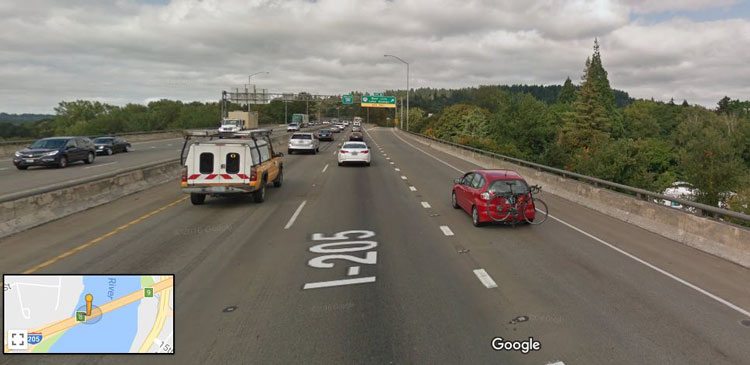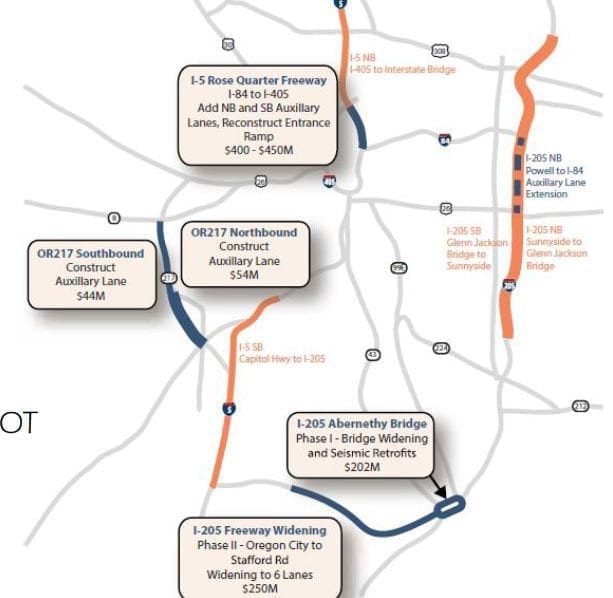John Ley
For ClarkCountyToday.com
VANCOUVER — Oregon lawmakers want Southwest Washington citizens to pay tolls on both I-5 and I-205 “at the border” for Oregon road improvements.

The Oregonian is the latest to confirm this news.
“The transportation bill sends toll proceeds into a fund for widening much of the southernmost stretch of I-205, from Stafford Road to Oregon City, by adding a lane in each direction,’’ The Oregonian report stated. “It also directs money to replacing the Abernethy Bridge, which carries I-205 over the Willamette River in West Linn.”
Tolling would apparently begin in two years according to their plan.
While they will add “one lane in each direction” to I-205, they will add zero new lanes on I-5 at the Rose Quarter, which is the real “stop light” on I-5. According to a 2012 City of Portland report, the Rose Quarter has the HIGHEST accident rate of any section of road in Oregon.
The I-205 is two lanes wide to the west of the Willamette River. Oregon wants to spend $250 million adding a lane in each direction from the Abernethy Bridge to Stafford Rd, making it three lanes in each direction.
Additionally, Oregon wants to spend $202 million to replace the Abernethy Bridge according to The Oregonian. It is currently three lanes wide. Yet a graphic from the state report indicates it is “a seismic upgrade and widening.” The Abernethy Bridge is one of the newest bridges in our region. It opened in May 1970, according to Wikipedia. The Glenn Jackson Bridge (I-205) opened in 1982, and the Fremont Bridge opened in 1973. So a seismic upgrade seems more likely.
Here’s a Google photo of the current Abernethy Bridge.

As part of the Oregon Transportation package, they indicate they want to do “pre construction tolling” of both I-5 and I-205. They’re calling it a “Congestion Relief & Carbon Reduction Fund.“ They also want “congestion pricing” which means your tolls will be higher when the traffic jam is the worst, and less when the traffic is flowing more freely.
Yes, apparently owning and driving a vehicle is a “privilege” and Oregon lawmakers want to tax you for exercising that “privilege.”
Here is a graphic in the January 2017 Oregon Transportation Committee proposal showing projects in the Portland region.

The yellow lines on I-5 (two different areas) and on I-205, are what they label “Active Traffic Management” in the report. This appears to be where they want to have the “demand management” also known as tolls.
Oregon is proposing to add brand new lanes on I-205 from Stafford Rd. to Oregon City. They also want to replace (or upgrade) the Abernathy Bridge crossing the Willamette River. The total cost would be $452 million.
Two new lanes on I-205 at about six miles each, would cost $250 million, or about $20 million per mile to build a new freeway lane.
How much would it cost them to add two new lanes to I-5 at the 2-mile I-5 bottleneck at the Rose Quarter?
Instead, Oregon wants to spend an additional $450 million to mainly add two “lids” across I-5 at the Rose Quarter, which will do next to nothing to reduce traffic congestion. Here’s what they’re proposing at the Rose Quarter.

You can see “auxiliary lanes” for merging on/off I-5. You see bicycle and pedestrian crossings over I-5. And you see the two “lids” (in yellow) over the top of I-5. But there are no new through lanes on I-5 at the Rose Quarter, in Oregon’s proposal. I-5 will remain two lanes wide in each direction. Therefore, the impact of spending this $450 million (now possibly down to $338 million), will be a negligible improvement in traffic congestion and freight mobility in the region.
The Rose Quarter is a safety issue. It has the highest accident rate of any section of road in Oregon. It is three times the accident rate of the Terwilliger Curves, according to a 2012 City of Portland report. While the new longer “auxiliary lanes” for merging should help reduce accidents, the Rose Quarter will remain the bottleneck for I-5 in the region. Until Oregon is willing to add vehicle capacity by adding new through lanes, it will remain the section of road with the highest accident rate in Oregon according to ODOT’s own projections.
John Ley is a Camas resident who is a regular contributor to ClarkCountyToday.com, reporting on issues that impact area residents.




